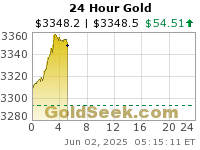Lately I have been wondering how the HUI Amex Gold Bugs Index has performed at critical turns in gold's repetitive secular bull market ABCD pattern - and particularly how it has behaved at the bottoming of the B and D phases of the pattern. This curiosity would seem to apply to our current trading as I believe gold is in the process of concluding the B-wave phase and just beginning to embark on the C-wave phase.
If you are interested in seeing the details of how the HUI behaved during each of gold's B-wave and D-wave bottoms from 2002 - 2012, read on as I have prepared charts for each instance that include price trend line breaks, fibonacci retracement measurements, day counts for the initial rallies, True Strength Index (TSI) indicator buy/sell signals given using the trend line break teachnique, and all referenced to the underlying price of gold.
I will recap some of my observations at the conclusion of the charts presentation.
Let's begin with a broad view of the HUI Gold Miner's Index price performance over the past 10 years. This first chart is a weekly beginning around June 2002.
Click on any chart to ENLARGE
This chart begins with gold's second ABCD pattern. The green arrows locate the BUY signal given by the trend line break technique of the TSI at each of the B-wave bottoms. Below the TSI indicator panel is a simple indicator I created to show the closing price of gold (/GC) along with its high and low price each day. This will be easier to observe in the following charts.
Finally, the Fibonacci retracement calculation reveals that the HUI bottom reached 4 weeks ago was nearly a perfect 50% retracement of the past 10 years upward price movement and that price last week bottomed on the 38.2% retracement and ended up closing $12-13 higher than that level for the week.
The green vertical lines spot the TSI BUY signals, the dark gray lines point to the SELL signals. Sometimes I point out the Negative/Positive Divergence BUY/SELL signals, but not always.
The lowest indicator panel shows the closing price of gold (dark blue) as well as the high and low price (red and light blue). Also seen in this panel is the location of gold's B-wave or D-wave bottom.
The red diagonal lines offer a price trend line and a count of the significant high and low trading days is given in blue.
Also provided are some Fibonacci measurements nested within larger rallies.
Next up are the B-wave and D-wave bottoms of 2004 and 2005.
And the D-wave/B-wave bottoms of 2006.
The infamous 2008 D-wave bottom followed by the B-wave bottom of April 2009.
And finally, our 2012 D-wave and current B-wave bottoms.
On the final chart I made some notes to myself in the upper left hand corner regarding my immediate expectations for the HUI/GDX trade. Basically, price and the TSI indicator have got themselves into an interesting situation. That is, if price rockets higher for the next couple of days it will create a negative divergence SELL signal. However, if price falls sharply and the TSI does not make a lower low (0.187) then that will yield a positive divergence BUY signal.
At present I am long NUGT - Direxion Gold Miners Bull 3X ETF - and I would welcome a couple of strong up days then unload. You may have noticed in the preceding charts that once a steep price up trend is broken (as seems to be the case in our current chart) it is usually only a matter of a day or two before price goes into correction mode (2003, 2004). And heck, maybe price continues higher and Friday's low becomes the new trend line. Who knows?
A couple of interesting things you may not have noticed. By the very rules of how gold's repetitive ABCD pattern are defined, the D-wave bottom is always lower than the following B-wave bottom. But the HUI is not obligated to follow these rules and in fact, we see examples of D-wave bottoms that are followed by an even lower B-wave bottom (notably May 2005 and May 2012).
And yes, the C-wave rally that followed the May 2005 B-wave bottom was a screamer. HUI went from $166 to $402 (142%) in just under 12 months. I have every reason to believe that something similar (probably much better) is in the cards for those who are patient investors of miners.
I hope the hours and hours I have spent making these charts will reward you will fresh insight and inspiration.
Have a great week,
John
tsiTrader@gmail.com
Ps. How do you like the accuracy of those TSI trend line break BUY/SELL signals (light green/light gray arrowed vertical lines)?






![[Most Recent Quotes from www.kitco.com]](http://www.kitconet.com/images/quotes_special.gif)




No comments:
Post a Comment